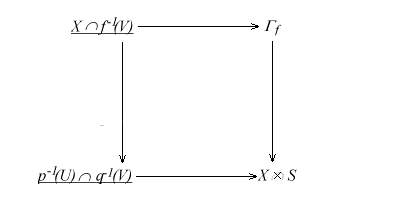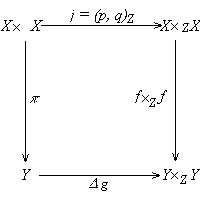|
Definition 6.1.1. An affine site is a strict metric site B with finite limits in which any object is separated and quasi-compact. Definition 6.1.2. An algebraic
site is a strict metric site C with finite limits together
with a basis B (called an affine basis)
having the following properties (a), (b) and (c):
Example 6.1.3.
All the basic algebraic sites considered in (1.1)
are affine or algebraic sites:
Note that all these sites satisfy (6.1.2.d) (For Sch see [H, p.116]) Example 6.1.4. An algebraic variety over an algebraically closed field k is a separated and quasi-compact prevariety over k. Denote by Var/k the category of algebraic varieties over k. Var/k is a standard site with finite limits. It is an algebraic site with AVar/k as an affine basis. For the remainder of this section we assume C is an algebraic site with an affine basis B. Any object of C which is isomorphic to an object of B is called an affine object. Enlarging B if necessary we may assume that B consists of all the affine objects. If X is any object of C, an effective open subset U of X is called affine if the open effective subobject U is affine. (6.1.2.b) and (6.1.2.c) implies that any separated morphism, monomorphism, regular monomorphism, etc., in B is also a separated morphism, monomorphism, regular morphism in C. We first study separated morphisms in an algebraic site C. Proposition 6.1.5. Suppose f: Y ® X is a bicontinuous morphism. Then for any x Î f(Y) there exists an affine open neighborhood U of x such that V = f-1(U) is affine. Proof. Replacing X by an affine neighborhood W of x and Y by f-1(Y), we may assume that X is affine. If x Î f(Y), there exists a unique y in Y such that f(y) = x. Suppose V is an open affine neighborhood of y in Y; then f(V) is an open neighborhood of x in f(Y)), thus there exists an open neighborhood U' of x such that U' Ç f(Y) = f(V); hence f-1(U') = V. Denote by f' the restriction of f to V. Then f': V ® X is a morphism of affine objects. Suppose U is an open affine neighborhood of x contained in U'. Then f-1(U) = f'-1(U) = V ×X U is affine. Proposition 6.1.6. Suppose X is an object such that for any pair U, V of affine open subsets of X, U È V is separated, then X is separated. Proof. The collection of all U È V forms an open diagonal cover of X by (5.3.9.b), hence the assertion follows from (5.3.6 and 5.3.10). Proposition 6.1.7. A morphism f: X ® S is separated if and only if for any open affine subset V of S, f-1(V) is separated. Proof. Suppose f is separated. Then f-1(V) is separated over the affine object V which is separated. Thus f-1(V) is separated (5.3.6.b). Conversely, if f-1(V) is separated, then it is separated over S (5.3.6.a). Since the collection of all such f-1(V) forms a diagonal covering of X (5.3.9.a), thus X is separated over S (5.3.10). Corollary 6.1.8. A morphism f: X ® S is separated if and only if for any pair of open affine subsets U, V of X such that f(U) and f(V) are contained in an affine open subset of S, U È V is separated. Proof. By (6.1.7) f is separated if and only if for any affine open subset W of S, f-1(W) is separated, i.e., if for any pair U and V of open affine subsets of f-1(W), U È V is separated (6.1.6). Lemma 6.1.9. Suppose X is covered by two affine open subsets U and V. Then X is separated if and only if the regular monomorphism t: U Ç V ® U × V induced by the inclusion morphisms i: U Ç V ® U and j:U Ç V ® V is a closed special morphism. (Note that the condition implies that U Ç V is affine if (6.1.2.d) holds for C since U × V is affine.) Proof. First we note that t: U Ç V = U ×X V ® U × V is a regular monomorphism (5.1.8). X is separated if and only if the image of the special morphism D: X ® X × X is closed (6.1.2.c). The object X × X is covered by three open subsets |U × U|, |V × V| and |U × V|. Since U, V are affine, they are separated (6.1.1). Thus D(U) = |D(X)| Ç |U × U| is closed in |U × U|, and D(V) = |D(X)| Ç |V × V| is closed in |V × V|. It follows that |D(X)| is closed in |X × X| if and only if t(U Ç V) = D(U Ç V) Ç |U × V| is closed. Proposition 6.1.10. Suppose f: X ® S is a morphism and S is separated. Suppose V is an affine open subset of S and U an affine open subset of X. There is a closed special morphism U Ç f-1(V) ® U × V (and U Ç f-1(V) is affine if (6.1.2.d) holds for C). Proof. Suppose (X × S, p, q) is the product. The subobject U Ç f-1(V) is the fibre product of the graph Gf and p-1(U) Ç q-1(V) over X × S. But p-1(U) Ç q-1(V) coincides with the fibre product U × V (4.2.7), thus it is an affine object. Since Gf ® X × S is a closed special morphism (thus universally closed (5.2.6)), its extension U Ç f-1(V) ® p-1(U) Ç q-1(V) is a closed special morphism.  Next we study quasi-separated and quasi-compact morphisms in an algebraic site C. Proposition 6.1.11. Suppose f: X ® Y is a morphism. Then f is quasi-compact if and only if for any affine open cover {Vi} of |Y|, f-1(Vi) is quasi-compact for each i. Proof. Suppose {Vi} is an affine open cover of |Y| such that each f-1(Vi) is quasi-compact. Let {Uij} be a finite affine open cover of f-1(Vi). For each open affine subset Z of Vi, f-1(Z) is then the union of the affine open subsets f-1(Z) Ç Uij = |Z ×Y Uij|, hence quasi-compact. The open effective subsets Z of |Y| such that f-1(Z) is quasi-compact thus form a basis; hence f is quasi-compact by (5.4.9.a). The other direction is obvious. Proposition 6.1.12.
Suppose X is an object. The following properties are equivalent:
Proof. The properties (b) and (c) are equivalent
by the definition of a quasi-compact morphism; (c) implies (d) trivially.
Corollary 6.1.13. Any object X whose underlying space is locally noetherian is quasi-separated. If this is so then any morphism f: X ® Y is also quasi-separated. Proposition 6.1.14.
(a) Suppose f: X ®
Y is a quasi-compact S-morphism. Then for any base extension g: S'
® S, fS':
XS' ®
YS' is quasi-compact. Thus any quasi-compact morphism is
universally quasi-compact.
Proof. Clearly (a) implies (b) and (c). To prove (a), suppose f is quasi-compact. To prove that fS' is quasi-separated, we may assume S = Y. Let (X ×S S', p, q) be the fibre product. Consider an affine open set U of |S'| such that g(U) Í V for an affine set V of |S|. Such open sets U forms a basis for |S'|, thus by (5.4.9.a) it suffices to prove that q-1(U) = |f-1(V) ×V U| is quasi-compact. Since f and V are quasi-compact, f-1(V) is quasi-compact, thus it is a finite union of affine open sets {Wi}, hence q-1(U) = |f-1(V) ×V U| is a finite union of affine objects Wi ×V U. Thus q-1(U) is quasi-compact. This proves the assertion. Proposition 6.1.15. Suppose the composition g.f of two morphisms f: X ® Y, g: Y ® Z are quasi-separated, and f is quasi-compact and surjective. Then g is quasi-separated. Proof. The morphism Dgf = jDf (see the proof of (5.3.4.c)) is quasi-compact by assumption.  Proposition 6.1.16. Suppose f: X ® Y, g: Y' ® Y are two morphisms and g is quasi-compact and surjective. If fY': XY' ® Y' is quasi-compact (resp. quasi-separated), then f is quasi-compact (resp. quasi-separated). Proof. For simplicity we shall write X'
for XY' and f' for fY'.
Proposition 6.1.17. Suppose the composition gf of two morphisms f: X ® Y, g: Y ® Z is quasi-compact. If g is quasi-separated, or the underlying space of X is locally noetherian, then f is quasi-compact. Proof. (a) First consider the case that g
is quasi-separated. By (5.1.12) f
= Gf.p2
where p2: X ×Z Y
® Y is the projection,
and p2 = (gf) ×Z 1Y.
Since by assumption gf is quasi-compact, p2 is
so by (6.1.12.b). Since g is quasi-separated,
Dg: Y
® Y ×Z
Y is quasi-compact, using the diagram of (5.1.7)
(exchange X and Y and let S = W)) we see that
Gf is
quasi-compact (6.1.12.a). Thus f is quasi-compact
(5.4.5.a).
Proposition 6.1.18.
Assume (6.1.2.d) holds for C.
Proof. First we prove the assertion under the assumption
that Y is separated. Since X is quasi-compact, |X|
is a finite union of open affine sets Ui. Since (6.1.2.d)
holds for C, we may apply (6.1.10) to see
that for any affine open set V of |Y|, f-1(V)
Ç Ui
is open affine, hence quasi-compact, thus f-1(V)
is quasi-compact. The assertion then follows from (6.1.11).
|